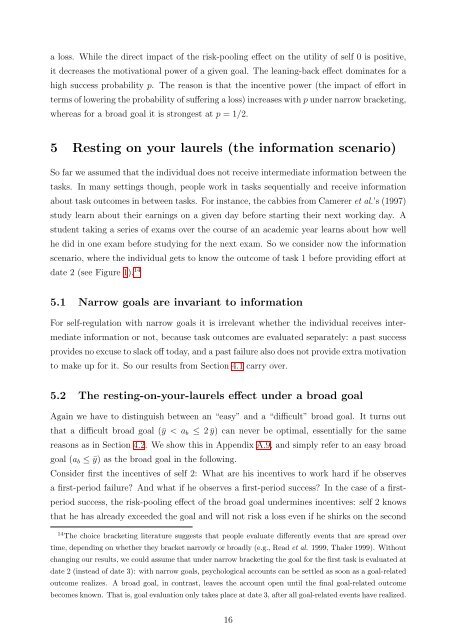Motivational Goal Bracketing - School of Economics and ...
Motivational Goal Bracketing - School of Economics and ...
Motivational Goal Bracketing - School of Economics and ...
Create successful ePaper yourself
Turn your PDF publications into a flip-book with our unique Google optimized e-Paper software.
a loss. While the direct impact <strong>of</strong> the risk-pooling effect on the utility <strong>of</strong> self 0 is positive,<br />
it decreases the motivational power <strong>of</strong> a given goal. The leaning-back effect dominates for a<br />
high success probability p. The reason is that the incentive power (the impact <strong>of</strong> effort in<br />
terms <strong>of</strong> lowering the probability <strong>of</strong> suffering a loss) increases with p under narrow bracketing,<br />
whereas for a broad goal it is strongest at p = 1/2.<br />
5 Resting on your laurels (the information scenario)<br />
So far we assumed that the individual does not receive intermediate information between the<br />
tasks. In many settings though, people work in tasks sequentially <strong>and</strong> receive information<br />
about task outcomes in between tasks. For instance, the cabbies from Camerer et al.’s (1997)<br />
study learn about their earnings on a given day before starting their next working day. A<br />
student taking a series <strong>of</strong> exams over the course <strong>of</strong> an academic year learns about how well<br />
he did in one exam before studying for the next exam. So we consider now the information<br />
scenario, where the individual gets to know the outcome <strong>of</strong> task 1 before providing effort at<br />
date 2 (see Figure 1). 14<br />
5.1 Narrow goals are invariant to information<br />
For self-regulation with narrow goals it is irrelevant whether the individual receives inter-<br />
mediate information or not, because task outcomes are evaluated separately: a past success<br />
provides no excuse to slack <strong>of</strong>f today, <strong>and</strong> a past failure also does not provide extra motivation<br />
to make up for it. So our results from Section 4.1 carry over.<br />
5.2 The resting-on-your-laurels effect under a broad goal<br />
Again we have to distinguish between an “easy” <strong>and</strong> a “difficult” broad goal. It turns out<br />
that a difficult broad goal (¯y < ab ≤ 2 ¯y) can never be optimal, essentially for the same<br />
reasons as in Section 4.2. We show this in Appendix A.9, <strong>and</strong> simply refer to an easy broad<br />
goal (ab ≤ ¯y) as the broad goal in the following.<br />
Consider first the incentives <strong>of</strong> self 2: What are his incentives to work hard if he observes<br />
a first-period failure? And what if he observes a first-period success? In the case <strong>of</strong> a first-<br />
period success, the risk-pooling effect <strong>of</strong> the broad goal undermines incentives: self 2 knows<br />
that he has already exceeded the goal <strong>and</strong> will not risk a loss even if he shirks on the second<br />
14 The choice bracketing literature suggests that people evaluate differently events that are spread over<br />
time, depending on whether they bracket narrowly or broadly (e.g., Read et al. 1999, Thaler 1999). Without<br />
changing our results, we could assume that under narrow bracketing the goal for the first task is evaluated at<br />
date 2 (instead <strong>of</strong> date 3): with narrow goals, psychological accounts can be settled as soon as a goal-related<br />
outcome realizes. A broad goal, in contrast, leaves the account open until the final goal-related outcome<br />
becomes known. That is, goal evaluation only takes place at date 3, after all goal-related events have realized.<br />
16
















